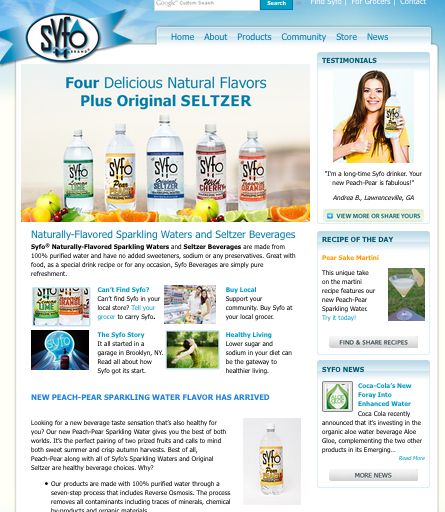No, I don’t mean whether you invariably spill drinks on people at parties or find it hard to start up conversations with strangers (although there are probably virtual equivalents to both). I’m referring of course to your social marketing efforts. Plenty of businesses spend lots of time on social marketing. Some measure effectiveness by the amount of followers or likes, how many comments they get, reach, or how many “influencers” they create (people that can affect other people’s purchase decision). Others even trot out the vintage Larry Tate (of Bewitched fame) or Madmen adage of brand awareness. Few can tell you what they’re actually getting out of it when it comes to booked business. Many do it because they read they should be doing or because they like it (hey, I’m on Facebook and Twitter all the time anyway). This is the equivalent of a job candidate saying I like to work with people because I’m a people person. This article from Web Marketing Today makes a valiant attempt to give you a framework for putting some metrics around social. What strikes me is that of all of those listed, only one — clicks to the website from social channels and the resulting conversions — are hard metrics. That’s not the fault of the author, it’s simply the nature of the beast. From social interaction through engagement to the sale is a complicated chain and it can be difficult to discern what generated the behavior that resulted in a sale. A person could go to your website directly or through branded search (typing in your business name). There is no definitive way to know what generated that behavior — advertising, social influence or even a prior search. So the bottom line is, you have to be careful to calibrate the money, time and resources you put toward social with what you think you are tangibly getting out of it. Now if you can marry social with the search dynamic, that’s a whole other story. And yes, the topic of a future blog...
Read MoreAnother from the Everyday Marketing Advice archives: This article in the New York Times gives helpful and practical tips for creating watchable, informative videos that may or may not get rapidly shared. But the hope of going viral is kind of like the hope of winning the lottery — no matter how strategically you play the numbers it’s probably not going to happen. That doesn’t mean businesses shouldn’t have videos — in particular YouTube videos — as part of their marketing mix. Of far more practical value is the opportunity to get a stronger presence in the search engines. A video, strategically targeted to search terms that reflect what you do, can: Give you another way to appear on the search-engine results page as Google blends video or YouTube items with the other results from the search query Strengthen the content on your website, helping to optimize it for search When uploaded to your Google Places/Google+ Local listing, optimize your business for local search (learn why local search is now so important) Gives you another avenue to build links to your site. This article gives some useful tips on how to use video as a search engine tool. Some of the highlights: Open a YouTube channel and include in the title keywords that are relevant to what you do Add descriptions and video transcriptions Strategically use tags Embed your videos on your website, including text that describes the video and even include a video transcription Create a video...
Read MoreAs Hurricane Hermine was preparing to strike the Florida Panhandle last month, here in Northeast Florida I was deluged by a torrent of another kind — wall-to-wall “storm coverage” by both local and national news outlets. Now although the storm did create some serious havoc along its direct path, we along the fringes were subject to breathless speculation about wind speeds, rainfall levels, storm path possibilities — all widely varying and as it turns put completely wrong. On top of that you had local politicians posturing to be somber and leader-like, intoning on how prepared they were and why we should take this threat seriously. This scenario has played out several times over the last few years as we’ve been lucky enough to escape major storms here in the hurricane capital of the U.S. (Hermine was the first hurricane to strike Florida since 2005). And you get the sense (justified or not) that the media weather departments can’t wait to put their crack storm watch teams into some live action, sort of like invading a country because you want to do something with all that gear and training. The problem with all this of course is that people start to tune the information out — sure, whatever you say, heard it all before — and then when there’s a real need to, they won’t be listening. But Larry, you might ask, beyond your usual grousing, what does this have to do with marketing since this is a marketing blog? Well I’m getting to that. I’ve run across so many companies who think that more is necessarily better. Flood the Facebook page with posts. Send out those email blasts every other day. I actually ran across a prospect who placed the same print ad every day in the same position in the paper. This is obviously counter-productive from a communications standpoint. You become like wallpaper and people start to tune you out. What’s more, with email marketing, open and click-through rates diminish with increased frequency and with Facebook, the more posts you throw out there with no engagement, the less likely you are to get in anyone’s feed. So pick your spots carefully. Make sure you have engaging content with...
Read MoreThis was originally posted on my Everyday Marketing Advice blog. Think AOL was hopelessly square? Think again if you use Facebook. What am I: An internet property that organizes and filters Web content for its users. A place where people can keep in contact and share things with family and friends. A service you can find like-minded people with similar interests in groups. And it includes a messaging application where you can instantly chat with anyone with whom you chose to connect. Of course I’m describing Facebook, right? Wrong. I’m talking about AOL. Yes your grandma’s AOL. It’s not that much of a secret that the idea of a “behind the fence” or “gated” internet community was first manifested by that old dinosaur AOL, and is what in part inspired Mark Zuckerberg to do the same. It’s also apparent that the old AOL “away” message is the antecedent of the Facebook status update. But there are important behavioral differences and these are critical to marketers. In addition to providing access to the Web, AOL was a place where people sorted through the internet for solutions to their problems, conduct research, access services and to buy things. So in many ways it was closer to Google than Facebook. And hence there’s the rub with Facebook. Facebook is not the place where people go for information, to research solutions or to buy stuff. They go to keep up with their friends, for amusement and, let’s face it, to be diverted. Someone who’s looking for diversion may not exactly be in the buying mode. Even when it comes to news, I know very few people who use Facebook as their primary news source, and if they do, I fear how they might vote in the coming election. So yes, there are millions and millions and millions of users that spend hours a day on Facebook. But just because they are there, it doesn’t make them ripe for the picking. There used to be the same numbers of people watching Friends on TV in the 1990s, but, except for the most big-bucks marketers, were they looking to buy what businesses had to...
Read More



